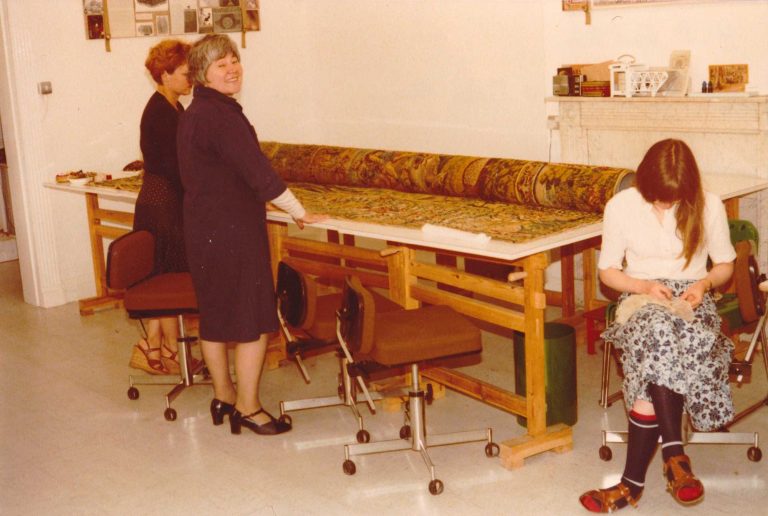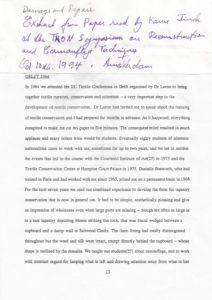How To Repair A Tapestry
Observations on impairment and repair of tapestry
Oct 10th, 1994
Extract from newspaper read by Karen Finch at the TRON symposium in Amsterdam on reconstruction and camouflage techniques

Delft 1964
In 1964 we attended the IIC Textile Briefing in Delft organised past Dr Leene to bring together textile curators, conservators and scientists – a very important pace in the development of textile conservation. Dr Leene had invited me to speak about the preparation of textile conservators and I had prepared for months in accelerate. Equally it happened, everything conspired to make me cut my paper to five minutes. The consequent relief resulted in much applause and many letters from would exist students. Somewhen eighty students of xix nationalities came to work with me, sometimes for upwardly to ii years, and we prepare in motion the events that led to the course with the Courtauld Establish of Art (25) in 1973 and the Fabric Conservation Eye at Hampton Court Palace in 1975. Danielle Bosworth, who had trained in Paris and had worked with me since 1965, joined me on a permanent footing in 1968. For the adjacent seven years we used our combined experience to develop the form for tapestry conservation that is now in general use. It had to exist uncomplicated, aesthetically pleasing and give an impression of wholeness fifty-fifty when large parts are missing – though not often as large as in a rare tapestry depicting Moses hit the rock, that was found wedged between a cupboard and a damp wall at Saltwood Castle. The linen lining had totally disintegrated throughout only the wool and silk were intact, except directly behind the cupboard – whose shape is outlined by the remains. Nosotros taught our students (27) about camouflage, and to work with abiding regard for keeping what is left and drawing attention away from what is lost – sometimes by very uncomplicated expedients, such as stitching the silver stains in a Mortlake tapestry at Kensington Palace in place and making them pretend to exist silvery highlights nevertheless. Danielle introduced colour indications into the couching and devised how to put back the dark outlines in Gothic tapestries on which their design depends. Virtually of these have been rewoven several times earlier. In one Esther tapestry (28) woven at Tournai we plant testify of iii or four reweavings (29).
We prepared our students, whether at Ealing or Hampton Courtroom, for finding their ain mode by didactics them basic principles. Each commission added some other facet to both their experience and ours and confirmed the impossibility of laying down unbreakable rules when dealing non just with works of art, but also with by restorations and the rights of owners to treat their possessions according to the use they want to make of them.
Our private experiences, our educational background and the culture in which we grew upwardly all influence our thinking. It took a long time for me to have that my grooming in weaving and blueprint did non authorize me to understand the thinking behind the work of craftsmen and women of some other historic period – or the complicated motivations of their patrons. The creative power of conservators should not atomic number 82 them to "better" an original piece of work. Objects have to speak for themselves.
Any "comeback" may become ludicrous to the adjacent generation – every bit is the reweaving of the brownish eyes of Clemency in the Three Fates tapestry (thirty) at the Victoria and Albert Museum that now expect at us through the make-up of a 1940s film star and the leg in the Anthony and Cleopatra tapestry in the Goldsmith's Hall which a Victorian sense of decency had caused to be rewoven to match Anthony'due south draperies. It reappeared in the grade of fading.
The ethics of each age are impressed on all its creations – and that includes us.
Dancing on Christmas Eve
It took a long time for me to accept that my training in weaving and design did not authorize me to sympathise the thinking behind the piece of work of craftsmen and women of another age
The strangest tapestry I was always asked to conserve was shown at the International Treasures Exhibition at the Victoria and Albert Museum in 1962. I saw it there and took it to date from most 1500. It depicts a dancing scene with four couples and two musicians – one playing a pulsate, the other a flute. The tapestry was dirty and looked in demand of repair. I wanted to make information technology better, and was pleased when I was asked to conserve information technology in about 1964.
We soon discovered several discrepancies in the material and techniques for which it was difficult to find an caption. The warp yarns plied from hard twisted singles, would take fabricated beating down the weft very difficult. The holes seemed to be structural and role of the weave. Too, they appeared in blue or light-coloured places that are ordinarily very resistant to decay. The weft yarns went over only a few warps at the time and would plough several times in the same colour area. Some of the xanthous and light-green colours were unusual in a medieval tapestry – mainly considering they had not faded. The musician on the right appeared to consist of ii unconnected pieces. Just every bit nosotros had finished the repair, we received a Christmas card from the Pierpoint Morgan Library in New York, showing a woodcut with the same design. It had been taken from the Nuremberg Chronicles of 1493 past Hartmann Schedel – artist Anton Koberger. He had called it "Dancing on Christmas Eve". People who danced on Christmas Eve were doomed to dance the whole year through.
Nosotros had noticed the united nations-medieval treatment of the faces with their tired expressions, that suggested exhaustion consistent with June! Soon later, some other tapestry woven from some other illustration in the aforementioned Nuremberg Chronicles came to the Victoria and Albert Museum for advice – this time with its origin fully documented. Information technology had been woven in an American workshop nigh the turn of the century.
Many people had been involved in our search including students from around the world and and in 1990 came a strange twist – on a visit to erstwhile students in Prague we were taken to the Castle of Zvíkov for an afternoon visit. Nosotros had enjoyed talking over lunch and it was late when nosotros entered a room with an amazing 15th century fresco. Amazing considering it depicted our tapestry, but with one more couple and a child or a jester in particoloured wearing apparel. I used my remaining moving picture – but the calorie-free had near gone.
Nosotros learned that the fresco had been restored in the 19th century. Presumably it had been there for as long as they said it had. While pondering this idea I realised that the woodcut would have been made after the artist had seen the fresco and then I wondered virtually the sources of his other inspirations and if we should e'er know.
Uppark – Chair covers designed by Danthon and woven in London about 1800
The chair covers had been at Uppark during the life of the wife of their kickoff possessor. She had taken exemplary care of all the furnishings there. Her successors had equally good intentions, but non every bit much success. The silk in the chair covers had well-nigh all disappeared and the dark majestic wool background to the Aesop fables designs had changed colour and become a nondescript faded brownish. The surface texture was harsh and fibroid to the experience.
I was informed that all the textiles on display had been regularly sprayed with a solution of Saponaria in water considering this was believed to be benign. I idea about this and realised that the spraying had created the weather condition for bleaching out of doors – with the Saponaria providing the element of group i ingredient and the grit on the covers the acid function. Washing out the Saponaria restored some of the softness of the wool and couching with colours indications put back a semblance of the silk.
Inverary Castle – Beauvais tapestries of virtually 1785
These fine silk tapestries had suffered water damage during a fire. The h2o had come up through the plasterwork ceiling and had picked upwards lime on the mode, which had made the silk hard and brittle. The lime had to be washed out, but the dyestuffs of the tapestries, existence products of their time, were highly doubtable. After much deliberation and many tests in a remarkably short time, Saponaria was called for the detergent.
Miraculously the colours were revived every bit the lime came out and the tapestries became quite strong and supple again.
Lyme Park Manchester – Hero and Leander tapestries woven at Mortlake, 17th century
The success with the Beauvais tapestries led us to consider more than apply of Saponaria – which is after all one of the oldest detergents we know. The next opportunity came with the Hero and Leander tapestries – but Saponaria fabricated no impression on their engrained dirt at all. Perhaps the differences are related to the Inverary tapestries beingness kept in the clean air of the Highlands of Scotland and the Hero and Leander tapestries in the industrial pollution of the environs of Manchester.
All in all these experiences suggest a need for further inquiry.
Regal Windsor Tapestry Mill, Merton Abbey Workshops
The differences between the effects of natural dyestuffs and the synthetic dyestuffs of the 19th century has caused much visual harm to tapestries by not being recognised by tapestry repairers and conservators.
Unfaded yarns dyed with 19th century synthetic dyestuffs may look like yarns dyed with natural dyestuffs, simply the deviation after exposure to light and different types of pollution is startling. Yarns dyed with 19th century synthetic dyestuffs tend to change into gold brown colours, sometimes fifty-fifty a potent red-dark-brown, quite a agonizing colour. Disturbing because of existence unintended. Yarns dyed with natural dyestuffs mostly retain their intended colour, except of course for fading. Both types fade harmoniously when non mixed. It is only when used for repair on each other, that the consequence is displeasing.
The effects of the two types of colouring is well illustrated by comparison tapestries woven at approximately the same fourth dimension – one with synthetic, the other with natural dyestuffs. Synthetic dyestuffs were used for a delineation of a knight owned past Gordon Cullingham (author of the illustrated handlist "The Royal Windsor Tapestry Manufactory", published past the Royal Borough of Windsor and Maidenhead in 1979) and natural dyestuffs for the ship tapestry owned past Birmingham Museum and Art Gallery, which was woven at the Merton Abbey Workshops. This manufactory is described by Oliver Fairclough and Emmeline Leary in "Textiles by William Morris and Morris & Co., 1861-1940" published by Thames & Hudson in 1981.
Other differences included that the Windsor Manufactory used entirely traditional tapestry weaving techniques, while the Merton Abbey weavers were more adventurous. Their attempts at lifelike representation past letting the weaving outline grasses and other natural forms unfortunately acquired warring tensions in the tapestries, which in 1 narrow tapestry depicting a ship caused twisting when hanging. In wider tapestries, their weight tended to even out the irregularities.
When using modern dyestuffs, the bug of concern to tapestry conservators prevarication mainly in their calorie-free reflecting qualities – or and so it appears now. All the same, no dyestuff is totally permanent and we shall be best suited by using as few replacement yarns as possible.
Related posts
-
Article
The educational activity of textile restorers
Source: https://karenfinchtextiles.com/observations-on-damage-and-repair-of-tapestry/
Posted by: goldbergwilts1937.blogspot.com



0 Response to "How To Repair A Tapestry"
Post a Comment